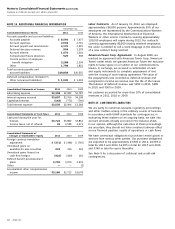AT&T Wireless 2011 Annual Report Download - page 90
Download and view the complete annual report
Please find page 90 of the 2011 AT&T Wireless annual report below. You can navigate through the pages in the report by either clicking on the pages listed below, or by using the keyword search tool below to find specific information within the annual report.
Notes to Consolidated Financial Statements (continued)
Dollars in millions except per share amounts
88 AT&T Inc.
NOTE 12. SHARE-BASED PAYMENT
We account for our share-based payment arrangements based
on the fair value of the awards on their respective grant date,
which may affect our ability to fully realize the value shown
on our consolidated balance sheets of deferred tax assets
associated with compensation expense. Full realization of
these deferred tax assets requires stock options to be
exercised at a price equaling or exceeding the sum of the
exercise price plus the fair value of the options at the grant
date. We record a valuation allowance when our future
taxable income is not expected to be sufficient to recover the
asset. Accordingly, there can be no assurance that the current
stock price of our common shares will rise to levels sufficient
to realize the entire tax benefit currently reflected on our
consolidated balance sheets. However, to the extent we
generate excess tax benefits (i.e., that additional tax benefits
in excess of the deferred taxes associated with compensation
expense previously recognized) the potential future impact on
income would be reduced.
At December 31, 2011, we had various share-based payment
arrangements, which we describe in the following discussion.
The compensation cost recognized for those plans was
included in operating expenses in our consolidated statements
of income. The total income tax benefit recognized in the
consolidated statements of income for share-based payment
arrangements was $187 for 2011, compared to $196 for 2010
and $121 for 2009.
Under our various plans, senior and other management
employees and nonemployee directors have received stock
options, performance stock units, and other nonvested
stock and stock units. Stock options issued through
December 31, 2011, carry exercise prices equal to the market
price of our stock at the date of grant. Prior to 2006,
depending on the grant, stock options vesting could occur up
to five years from the date of grant, with most options vesting
ratably over three years. Stock options granted as part of a
deferred compensation plan do not have a vesting period;
since 2006, these are the only options issued by AT&T.
We grant performance stock units, which are nonvested stock
units, to key employees based upon our stock price at the
date of grant and award them in the form of AT&T common
stock and cash at the end of a three-year period, subject to
the achievement of certain performance goals. We treat the
cash portion of these awards as a liability. Other nonvested
stock and stock units are valued at the market price of our
common stock at the date of grant and vest typically over a
two- to five-year period. As of December 31, 2011, we were
authorized to issue up to 121 million shares of common stock
(in addition to shares that may be issued upon exercise of
outstanding options or upon vesting of performance stock
units or other nonvested stock units) to officers, employees
and directors pursuant to these various plans.
The following table provides information for our supplemental
retirement plans with accumulated benefit obligations in
excess of plan assets:
2011 2010
Projected benefit obligation $(2,294) $(2,270)
Accumulated benefit obligation (2,223) (2,154)
Fair value of plan assets — —
The following tables present the components of net periodic
benefit cost and other changes in plan assets and benefit
obligations recognized in OCI:
Net Periodic Benefit Cost 2011 2010 2009
Service cost – benefits earned
during the period $ 14 $ 12 $ 11
Interest cost on projected
benefit obligation 126 134 140
Amortization of prior service cost 2 2 5
Actuarial (gain) loss 81 186 82
Net supplemental retirement
pension cost $223 $334 $238
Other Changes Recognized in
Other Comprehensive Income 2011 2010 2009
Prior service (cost) credit $6 $(5) $(5)
Amortization of prior
service cost (credit) 1 (2) (3)
Total recognized in other
comprehensive (income)
loss (net of tax) $7 $(7) $(8)
The estimated prior service credit for our supplemental
retirement plan benefits that will be amortized from
accumulated OCI into net periodic benefit cost over the
next fiscal year is less than $1.
Deferred compensation expense was $96 in 2011, $96 in
2010 and $95 in 2009. Our deferred compensation liability,
included in “Other noncurrent liabilities,” was $1,020 at
December 31, 2011, and $1,003 at December 31, 2010.
Contributory Savings Plans
We maintain contributory savings plans that cover
substantially all employees. Under the savings plans, we
match in cash or company stock a stated percentage of
eligible employee contributions, subject to a specified ceiling.
There are no debt-financed shares held by the Employee
Stock Ownership Plans, allocated or unallocated.
Our match of employee contributions to the savings plans is
fulfilled with purchases of our stock on the open market or
company cash. Benefit cost is based on the cost of shares or
units allocated to participating employees’ accounts and was
$636, $607 and $586 for the years ended December 31, 2011,
2010 and 2009.
























